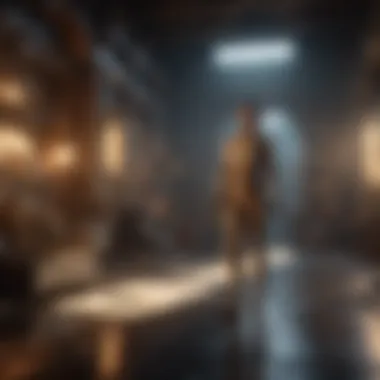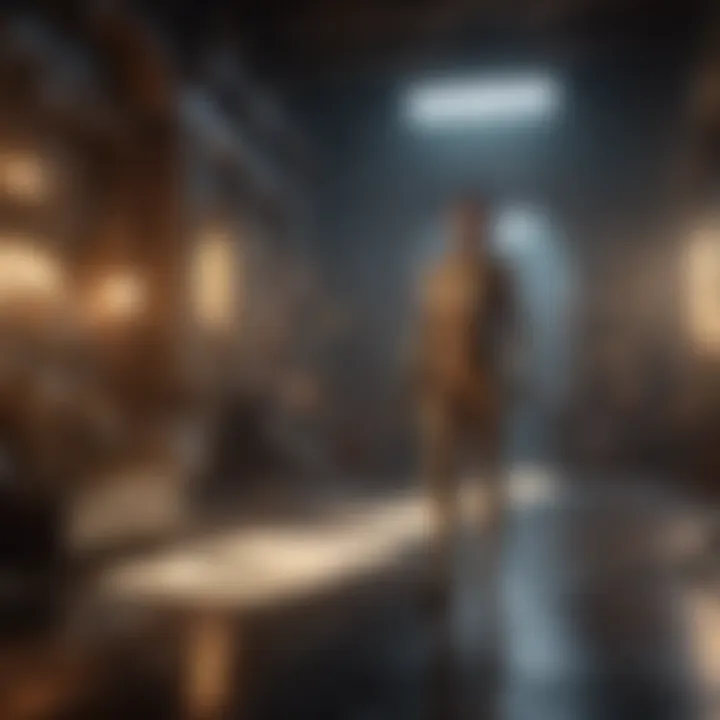Exploring the Release Timeline of the Skywalker Saga


Intro
The adventure within the Skywalker Saga has a convoluted yet fascinating timeline. From the first flicker of lightsabers on screen to interactive gaming experiences, this saga has found its way into various mediums, impacting the gaming community and fans around the world. Notably, the collaboration with Nintendo has blended storytelling and cinematic wonders into a realm of gaming that is equally thrilling and rewarding.
In exploring the release timeline, we uncover the factors that contributed to its evolution: the shifts in game design philosophies, fan expectations, and the marketing strategies that kept enthusiasts engaged. As players navigate through the game mechanics and storyline, they experience not just a game but a piece of the larger Star Wars legacy. This article takes a closer look at those pivotal moments and decisions, guiding gamers through the intricate layers that make up the Skywalker Saga.
Throughout this exploration, various sections will break down critical elements, including game reviews, character insights, and updates from the Nintendo front. By the end, readers should find themselves equipped with the knowledge to appreciate the significance of the Skywalker Saga far beyond just the pixels on their screens.
Historical Context of the Skywalker Saga
The Skywalker Saga is not just a collection of stories; it's a cultural phenomenon that has left imprints across different mediums. Understanding the historical context behind this saga is essential in grasping its significance, particularly in relation to the gaming world, where titles like those coming from Nintendo continue to resonate with both new and longtime fans. This context reveals how the saga evolved, how it was birthed from simple ideas, and how it adapted to technological advancements and audience demands.
Origins and Initial Concepts
The origins of the Skywalker Saga can be traced back to the imaginative genius of George Lucas. Initially, Lucas envisioned a space opera that combined elements of classical mythology with the high-stakes drama of heroism and sacrifice. The first film, released in 1977, stunned critics and audiences alike, sparking a wave of interest that fundamentally changed filmmaking and merchandising strategies.
As the concept took shape, it showcased the interplay between the light and dark sides of the Force, epitomized by characters like Luke Skywalker and Darth Vader. The whimsical charms of droids like R2-D2 and C-3PO added comic relief, creating an engaging contrast to the overarching epic narrative. Audiences were pulled into a galaxy far, far away, but more importantly, they were invited to engage more deeply with the storylines through expanded media like comic books, animated series, and of course, video games. This laid the groundwork for a universe that would only grow over time.
The Evolution of the Franchise
As with any long-standing franchise, the Skywalker Saga has seen considerable evolutionary changes. From the original trilogy that defined the landscape of science fiction cinema, we moved into the 1990s with the prequel trilogy, which aimed to explain the backstory of beloved characters.
However, this evolution wasn't just about moving chronologically; it was also about technological advances that allowed for more sophisticated storytelling. The prequels utilized improved CGI, bringing to life environments and creatures that could only be imagined before.
Fast forward to the sequel trilogy, which introduced a new generation to the saga and heralded a confluence of returning characters and fresh faces. Alongside the cinematic releases, Nintendo and other gaming developers jumped into the fray with titles that explored this rich lore. Games like "Star Wars: Knights of the Old Republic" or the LEGO Star Wars series provided fans with new avenues to experience the galaxy. They enriched the franchise's tapestry, aligning with the saga's ability to adapt and grow with the expectations of an ever-evolving audience.
The legacy of the Skywalker Saga serves not only as entertainment but also sets a blueprint for future franchises by demonstrating the power of interconnected narratives across multiple platforms. As we dive deeper into the release timeline, we uncover just how pivotal each new addition has been in maintaining the saga's vitality.
Chronology of Key Releases
The release timeline of the Skywalker Saga stands as a testament to the franchise's development and its intricate relationship with both gamers and the broader entertainment landscape. Understanding this chronology is crucial for fans and analysts alike. Noting the timing of each release helps in dissecting patterns of gameplay evolution, marketing strategies, and even the shifts in player engagement. By tracking these specific moments, insights can be gathered about how each installment has contributed to the saga's legacy, shaping the community's expectations and experiences.
Milestone Events in the Timeline
Examining key milestones provides a framework for understanding how the saga has unfolded over decades. Certain releases not only marked the introduction of new gameplay dynamics but also transformed broader industry standards. Here are a few notable points that stand out:
- First Release: The saga kicked off with the launch of "Star Wars: The Force Unleashed" in 2008 on various platforms. It was an early modern entry that captured players, setting the stage for future adventures with fresh mechanics and a compelling narrative.
- The Expansion Era: The mid-2010s saw significant expansion in the form of "Star Wars: Battlefront" (2015) followed by its sequel in 2017. These releases not only emphasized multiplayer experiences but also brought iconic battle scenes to life, deeply resonating with fans of the film series.
- Transition to Adaptation: More recently, titles like "Star Wars Jedi: Fallen Order" (2019) highlighted a shift towards rich, narrative-driven experiences. It’s a clear reflection of how game designers began to understand and replicate elements from the movies in a way that profoundly engaged players.
In each of these milestones, the gaming community reacted distinctly, embracing new gameplay while reminiscing about past favorites. Furthermore, these instances have had lasting impacts, often influencing future titles and setting expectations based on past successes or failures.
Release Patterns of Previous Titles


Dissecting the release patterns of earlier titles reveals interesting trends, hinting at what fans can expect in the future.
- Consolation of Release Timing: Many games were initially aligned with cinematic releases or significant franchise anniversaries. For example, launching around holiday seasons seemed to be a common trend, allowing fans to engage over expanded breaks, notably during periods when many consumers indulge in video gaming.
- Franchise Stacking: The release of multiple titles in close succession can spark both excitement and fatigue among players. Off years have often been used to recharge and refine upcoming gameplay rather than just pumping out titles arbitrarily.
- Community Reaction Influences: Responses to gameplay, graphics, and narratives have informed developers on what works and what doesn't. Open forums and platforms like Reddit and social media have fueled intense discussions, shaping developers' decisions on new releases.
"The relationship between gamers and developers is not just transactional; it’s a conversation that grows richer with each milestone release, captivating both parties in an intricate dance of expectations and revelations."
In summary, the chronology of releases in the Skywalker Saga acts as a roadmap, revealing trends and patterns that help fans navigate through time. For both gamers and industry observers, understanding these timelines offers crucial insights into the past and future of this beloved franchise.
NindoHub's Insight into the Saga
When dissecting the layered narrative of the Skywalker Saga, NindoHub emerges as a pivotal resource for understanding the complex interplay between game releases and community interactions. It bridges the gap between developers and players by providing insights and forecasts that resonate deeply with fans of Nintendo’s iconic franchise. Without a doubt, examining NindoHub's contributions offers a fresh perspective on how this universe continues to evolve and capture the imagination of gamers worldwide.
Overview of NindoHub's Coverage
NindoHub's coverage of the Skywalker Saga is extensive and insightful. It does not merely churn out facts; instead, it weaves stories that help fans connect the dots regarding the timeline of events in the game’s development and release. From previews to in-depth reviews, NindoHub has been known to offer:
- Comprehensive Reviews: They don’t just summarize; NindoHub digs deep into the mechanics, offering critical assessments that help fans understand what each game brings to the table.
- Developer Insights: In many instances, they have provided quotes from developers, giving fans a glimpse into the creative process behind the scenes. This direct line to the creators adds a layer of authenticity to their coverage.
- Community Opinions: NindoHub actively engages with its audience, hosting discussions and forums where gamers share their thoughts. The aggregation of these voices creates a robust dialogue around the saga.
In short, NindoHub stands out by demystifying the gaming experience, making it accessible and engaging for both casual and serious gamers alike.
Winning Strategies for Fan Engagement
Understanding fan engagement is key to the success of the Skywalker Saga, and NindoHub employs various strategies to keep the community connected and excited:
- Regular Updates: Consistency is the name of the game. NindoHub ensures its readers are never left in the dark by providing timely updates on game releases, patches, and community events.
- Interactive Content: Quizzes, polls, and surveys about player preferences or experiences with the games prompt fans to voice their opinions. This two-way communication fosters a sense of belonging within the community.
- Themed Events: NindoHub often ties their engagement strategies to special dates—like anniversaries of game releases or major updates—creating buzz and anticipation within the community.
This proactive approach to fan engagement emphasizes the value NindoHub places on their audience, highlighting that community voices are as vital as the content they consume. By focusing on these strategies, NindoHub not only enhances its own visibility but strengthens the bond between players and the Saga.
Impact of Release Dates
The release dates of any major franchise can significantly influence its success, and the Skywalker Saga is no exception. Analyzing the impact of release timing reveals crucial insights into consumer behavior, market trends, and the overall reception of the titles. When Nintendo launches a game, especially one as prominent as those in the Skywalker Saga, timing becomes an essential cog in the wheel of commercial strategy. It isn't just about hitting the shelves at the right time; it's about strategically aligning with events, seasonal trends, and even competitive releases.
Connection Between Release Timing and Sales
Release timing bears a strong correlation with sales, effectively creating a rhythm that can make or break a title’s success. Launching a game during peak periods, such as holidays or significant gaming convention days, can exponentially increase visibility. Gamers tend to have more bandwidth to purchase and engage with new content during these times. For instance, when The Skywalker Saga: Battlefront II launched in November, the proximity to the holiday season was no accident.
Key factors include:
- Seasonal Trends: Certain months, particularly the holiday season, are associated with higher spending among consumers.
- Market Competition: Releasing a game too close to a highly anticipated title can dilute sales, as consumers have limited budgets and time.
- Game Development Cycle: The development team must also consider whether the game is fully polished. Releasing a buggy game can hurt sales and ignite negative word-of-mouth.
"The timing of a release can speak volumes regarding the confidence a brand has in its product."


During various release windows, it becomes evident how timing plays into overall sales performance. When LEGO Star Wars: The Skywalker Saga debuted, it perfectly aligned with the burgeoning interest around sci-fi adventures, driving sales to impressive heights. However, if the title had released when another major blockbuster was hitting the market, the outcome might have been far less rosy.
Consumer Expectations and Preparations
Consumer expectations play a substantial role in determining how well a game is received upon release. When has the gaming community felt uncertain? Usually, it stems from prolonged development cycles or poorly communicated launch dates. These factors fuel anxieties, often leading to a more cautious approach to buying on launch day.
Considerations here involve:
- Advance Marketing: Building anticipation through effective marketing campaigns and teasers can prime the audience, affecting their willingness to purchase.
- Engagement Strategies: Test demos or previews can draw in gamers who might be sitting on the fence.
- Betas and Trials: Allowing fans to sample a part of the game ahead of time sets the stage for expectations.
Frequent communication regarding release dates and accompanying content enhances consumer preparedness. Gamers appreciate knowing what lies ahead, just like crop farmers appreciate weather forecasts. The more certain they feel, the more likely they are to convert interest into action, often pre-ordering to ensure access to potential bonus features.
In summary, the impact of release dates is a multi-faceted topic that extends far beyond mere calendar placement. It intertwines with marketing effort, consumer psychology, and overall franchise health. Understanding these connections is vital for anyone keen to grasp the dynamics of the Skywalker Saga in its ever-evolving landscape.
Analysis of Community Responses
The release timeline of the Skywalker Saga doesn't exist in a bubble; it interacts richly with the community's reactions and insights. This section evaluates how gamers and critics respond to the releases, shedding light on collective sentiments that oftentimes steer future directions both within the gaming industry and within the franchise itself. Not only does this analysis reveal the effectiveness of marketing strategies, but it also illustrates how the fandom’s voice continually shapes the saga.
Whether a player is an infrequent visitor to the galaxy far, far away or a die-hard fan with lightsaber collectibles, their feedback serves as a significant barometer of success. In particular, understanding the ebb and flow of community responses helps creators fine-tune their approach. From expectations formed by teasers to the reception of actual gameplay, every piece of information shared by the community forms a tapestry of insights for developers.
Feedback from Gamers and Critics
In examining the reactions from both gamers and critics, a couple of themes emerge that provide a window into the community’s psyche. Feedback tends to converge on several areas:
- Gameplay Mechanics: Many reviews highlight how crucial the gameplay experience is. Gamers want a smooth ride; clunky controls can quickly diminish the excitement.
- Storyline Developments: A captivating narrative can make or break a title. Players have been known to express their thoughts in forums or social media, arguing passionately about plot holes or character arcs.
- Technical Performance: With advancements in technology, performance issues can often overshadow a well-crafted game. Crashes and bugs are frequently cited in reviews, making this a critical point of discussion.
Gamers often turn to platforms like Reddit and Facebook to air their views. Some might say a poorly executed release will draw ire similar to a Jedi's lightsaber failing to ignite.
"Critics have the ability to influence which games take off and which end up gathering dust on shelves," suggests one avid participant in a Reddit thread discussing game performance. This sentiment underlines the sway critics hold, but it’s the thoughtful feedback from loyal gamers that frequently tips the scale.
The Role of Social Media in Shaping Perception
In today’s digitized world, social media can't be underestimated. It acts as the town square of the contemporary era, where opinions are shared and trends are born. Platforms like Twitter, Instagram, and especially Reddit have been revolutionary in shaping how the community interacts with the Skywalker Saga. Through hashtags and shares, players express their enthusiasm, critique, or outright disappointment.
- Builds Hype: Social media campaigns often stir excitement around a new launch, turning anticipation into a palpable buzz. Creators encourage such momentum through sneak peeks and behind-the-scenes looks, but the community amplifies these efforts far beyond their marketing plans.
- Fostering Dialogue: Conversations spring up organically, often leading to viral threads that engage a wide audience. Gamers riff on features they love or hate, creating a feedback loop that developers can easily tap into for future projects. Sharing memes or commentary quickly becomes a shared language among players.
- Amplifying Voices: Perhaps one of the most compelling aspects of social media is its democratic nature. Every voice matters, whether it’s a casual player or a well-respected critic. This variability often leads to unexpected discussions and revelations about the games in question.
When it comes down to it, the interplay between traditional review platforms and social media illustrates a shift in how opinions evolve. The community, bolstered by these digital platforms, holds power and sway over the trajectory of future releases in the Star Wars universe and beyond.
Future Projections
Future projections for the Skywalker Saga are not merely a guess or speculation; they are integral to understanding its trajectory and potential impact. As avid fans already know, the gaming landscape is evolving rapidly, influenced by technology, player expectations, and market trends. Making informed predictions helps anticipate shifts in storytelling, gameplay mechanics, and overall community engagement.


The Importance of Future Projections
When discussing the future trajectory of the Skywalker Saga, it is vital to consider several specific elements that will shape what lies ahead. The gaming world today is a tapestry of innovation, where companies thrive by including their players in the narrative, thus using feedback to inform upcoming titles.
- Player Engagement: The voice of gamers has never been louder. Developers are increasingly valuing player feedback and repeatedly adapt their strategies based on community dialogues across platforms like Reddit and social media forums.
- Technological Advancements: The rise of technologies such as augmented reality (AR), virtual reality (VR), and artificial intelligence (AI) is poised to revolutionize gameplay experiences within the franchise.
- Economic Considerations: The financial backdrop can’t be ignored. Decisions made by Nintendo and other governing bodies will hinge heavily on market dynamics, trends, and player spending behavior.
- Narrative Evolution: The function of narrative in gaming continues to expand. Future entries need to strike a balance between traditional storytelling and modern interactive principles.
"The most successful franchises adapt to their audience, inviting them to participate in shaping their experience."
What Lies Ahead for the Skywalker Saga
Looking down the road, several potential frameworks can define the Skywalker Saga's future. One can speculate about potential game releases, spinoff titles, or even hierarchies of cross-platform opportunities.
- New Installments: Following the established release patterns may indicate that additional core titles will follow. Given the success of past games, creating sequels is a foregone conclusion; the real question is how they will innovate.
- Expanded Universes: Just as Marvel successfully extended its cinematic universe, digital adaptations could explore character backstories in mini-series or downloadable content (DLC) formats. These could deepen connections between existing narratives and new characters, thus enriching the lore.
- Collaboration with Other Franchises: Possible partnerships with other franchises could give new life to the gameplay experience and introduce diverse characters, enhancing both appeal and complexity.
Potential Directions for the Franchise
In considering paths forward for the Skywalker Saga, a few trends shine brightly on the horizon. Each direction carries its weight in possibilities and risks.
Embracing Multiplayer Elements
Multiplayer gameplay is increasingly popular. Incorporating strong multiplayer elements into the core of the franchise could reignite interest. Gamers relish the opportunity to collaborate and compete, opening doors to new game modes with cooperative campaigns or competitive challenges.
Nurturing a Richer Narrative Framework
Rather than relying solely on beloved characters, expanding narrative arcs to include original characters and plots could keep the story fresh and engaging. This can also allow for seasonal or episodic content that maintains a steady stream of engagement.
Sustainability and Inclusivity
Sustainability in game production and inclusivity in character selection can significantly impact audience perceptions. Gamers increasingly seek representation and ethics in gaming practices, thus informing the direction companies might take.
In summary, the future of the Skywalker Saga is far from set in stone. Opportunities abound, but the success or failure of these avenues will depend largely on how well developers listen to their community and adapt to the inevitable shifts of the gaming environment.
Closure
The conclusion serves as the cornerstone of our analysis on the Skywalker Saga’s release timeline. It encapsulates the myriad elements we've explored, highlighting the connections between release schedules and the emotive tapestry of the gaming community. This part crystallizes our insights and marks the end of a journey through release dates that have shaped not only gameplay experiences but also fan interactions and expectations.
Recap of Findings
In this exploration, we have traversed the intricate landscape of the Skywalker Saga, uncovering pivotal moments in its release history. We detailed how each title's timing was strategically decided to achieve maximum impact among players. Several key findings emerged from our analysis:
- Timing is Everything: Release dates have profound implications on sales and community buzz. For instance, major releases before holiday seasons generally see uplifts in sales and engagement.
- Era-Specific Expectations: Each game release brought its own unique set of expectations shaped by prior titles and the cultural backdrop at release. For example, the anticipation surrounding newer installments reflected a blend of nostalgia and fresh innovation.
- Marketing Tactics: The ways in which Nintendo has leveraged marketing strategies to cushion and hype releases was significant. The tailored approaches afforded by social media allowed the team to gauge player sentiment and adjust messaging in real-time.
These findings not only underscore the gravity of release schedules but also illustrate how they align closely with community sentiment and market dynamics.
Final Thoughts on the Saga's Legacy
The Skywalker Saga’s legacy is stitched into the fabric of gaming history. Its rise to prominence is not merely due to gameplay mechanics or graphic enhancements; it’s rooted in the story it tells and the community it cultivates. Much like the mythos of its narrative, the saga emphasizes themes of hope, struggle, and journey, resonating deeply with players.
As we cast our gaze towards the future, it becomes clear that this saga isn’t closing its doors. With ongoing community discussions, fan theories proliferating on platforms like Reddit and social media conversations buzzing away on Facebook, the future appears ripe with possibility. New storylines, characters, and even unique game mechanics await, keeping the spirit of the saga alive.
Ultimately, the interplay between release timing, community response, and franchise evolution showcases a cycle that thrives on anticipation and shared experience. Whether you were around for the original releases or have jumped into the saga during more recent years, each new development marries nostalgia with the thrill of discovery, ensuring the Skywalker Saga remains a relevant and cherished part of the gaming discourse.



